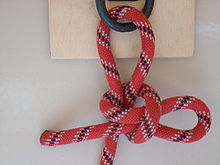Halter hitch
| Halter hitch | |
|---|---|
 |
|
| Category | Hitch |
| Related | Falconer's knot, Slippery hitch, Siberian hitch |
| Releasing | Quick-release |
| Typical use | tethering animals |
| ABoK | #243, #1715, #1804, #1826 |
The halter hitch is a type of knot used to connect a rope to an object. As the name implies it is useful in tying the lead rope, which is attached to the halter, to a post or hitching rail. The benefit of the halter hitch is that it can be released by pulling on one end of the rope. Even if there is tension on the rope, it can still be released with ease. Some sources show the knot being finished with the free end running through the slipped loop to prevent it from working loose or being untied by a clever animal, still allowing easy but not instant untying.
Halter hitch 1 : Place rope behind, through or around anchor object. Form a loop in the working part of the rope.
Halter hitch 2 : Pull a bight of the working part behind the standing part and then through the loop formed in first step.
The halter hitch is topologically the same knot as the Falconer's knot, i. e. a slipped overhand knot around the main part. The falconer has to tie the same knot one handed, throwing the end around the anchor object (the perch), gripping it with a scissoring fingers act, pulling the bight from opposite side of the main part using the back of the thumb.
Falconer's knot 1 : Pinching fingers from below, hooking thumb from above
Falconer's knot 2 : Hand rotated counterclockwise in a "GO AWAY" sign from below
Falconer's knot 3 : End bight scissored between fingers to thumb loop
Falconer's knot 4 : End bight slipped through loop around thumb
Falconer's knot 5 : Tightened by pulling main part, pushing the knot
Falconer's knot 6 : Locked with free end through slip
The halter hitch is similar to other slipped hitches that wrap the main part with small differences:
Siberian hitch
Slippery hitch
Untightened slipped buntline hitch
Half hitch with slip
...
Wikipedia
